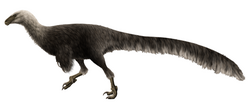Coelurosauria
Coelurosauria is the clade containing all theropod dinosaurs more closely related to birds than to carnosaurs.
| Coelurosaurians | |
|---|---|

| |
| A collection of coelurosaurian fossil skeletons: (Clockwise from upper left) GIN 100/42 which may represent Citipati or a different oviraptorosaur, Sinosauropteryx prima(a feathered compsognathid, Nothronychus mckinleyi(a therizinosaur), Tyrannosaurus rex(a large carnivorous tyrannosaur), Bambiraptor feinbergi(a small dromaeosaurid), Passer domesticus, Struthiomimus altus(an ornithomimid), Microraptor gui(a winged dromaeosaurid). | |
| Scientific classification | |
| Kingdom: | Animalia |
| Phylum: | Chordata |
| Clade: | Avetheropoda |
| Clade: | Coelurosauria von Huene, 1914 |
| Subgroups[1] | |
| |
This is a varied group that includes tyrannosaurs, ornithomimosaurs, compsognathids and maniraptors; Maniraptora includes birds, the only descendents of coelurosaurs alive today.
All Paraves discovered so far have been coelurosaurs. It is probable that all coelurosaurs were feathered.[5]
Some diagnostic characteristics of coelurosaurs include elongated arms and well-developed hinge-like ankles (possible rotation of the ankle is reduced, which is helpful during locomotion). These features may be lost or modified by later coelurosaurs (birds, for example).
An increase in the proportion of the brain occupied by the cerebrum seems to have occurred in the Coelurosauria and "continued throughout the evolution of maniraptorans and early birds".[6]
Fossil history
A few fossil traces of the Coelurosauria date back as far as the Upper Triassic.[7] A possible, but not confirmed, example would be the archosaur Protoavis. What has been found between then and the start of the late Jurassic is fragmentary.
Many nearly complete fossil coelurosaurians are known from the late Jurassic. Archaeopteryx is known from Solnhofen limestone at 155-150 million years ago (mya). Ornitholestes, the troodontid WDC DML 110, Coelurus fragilis and Tanycolagreus topwilsoni are all known from the Morrison Formation in Wyoming at about 150 mya. Epidendrosaurus and Pedopenna are known from the Daohugou Beds in China, whose age is still being debated, but may be about 160 Ma or 145 mya.
The wide range of fossils in the late Jurassic and morphological evidence suggests that coelurosaurian differentiation was virtually complete before the end of the Jurassic.
In the early Cretaceous, a superb range of coelurosaurian fossils (including avians) are known from the Yixian Formation in Liaoning. All known theropod dinosaurs from the Yixian Formation are coelurosaurs. Many of the coelurosaurian lineages survived to the end of the Cretaceous period (about 65 Ma) and fossils of some lineages, such as the Tyrannosauroidea, are best known from the late Cretaceous. Most coelurosaur groups became extinct in the K/T extinction event. Only the Neornithes (modern birds) survived, and continued to diversify into the numerous forms found today.
There is scientific consensus among paleontologists that birds are the descendants of coelurosaurs. Birds are classified by most paleontologists as belonging to the subgroup Maniraptora.[8]
Coelurosauria Media
Related pages
References
- ↑ 1.0 1.1 1.2 1.3 1.4 1.5 1.6 Holtz, Thomas R. Jr. (2012) Dinosaurs: The Most Complete, Up-to-Date Encyclopedia for Dinosaur Lovers of All Ages, Winter 2011 Appendix.
- ↑ Carrano, M.T.; Benson, R.B.J.; Sampson, S.D. (2012). "The phylogeny of Tetanurae (Dinosauria: Theropoda)". Journal of Systematic Palaeontology. 10 (2): 211–300. doi:10.1080/14772019.2011.630927. S2CID 85354215.
- ↑ Godefroit, Pascal; Cau, Andrea; Hu, Dong-Yu; Escuillié, François; Wu, Wenhao; Dyke, Gareth (2013). "A Jurassic avialan dinosaur from China resolves the early phylogenetic history of birds". Nature. 498 (7454): 359–362. Bibcode:2013Natur.498..359G. doi:10.1038/nature12168. PMID 23719374. S2CID 4364892.
- ↑ Andrea Cau (2018). "The assembly of the avian body plan: a 160-million-year long process" (PDF). Bollettino della Società Paleontologica Italiana. 57 (1): 1–25. doi:10.4435/BSPI.2018.01 (inactive 11 July 2025). Archived from the original (PDF) on 2018-12-21. Retrieved 2018-05-16.
{{cite journal}}: CS1 maint: DOI inactive as of July 2025 (link) - ↑ Currie, Philip J. (2005). Dinosaur Provincial Park: a spectacular ancient ecosystem revealed. Indiana University Press. p. 368. ISBN 0253345952.
- ↑ Larsson H.C.E. 2001. Endocranial anatomy of Carcharodontosaurus saharicus (Theropoda: Allosauroidea) and its implications for theropod brain evolution. pp. 19–33. In: Mesozioc Vertebrate Life. eds Tanke D.H; Carpenter K. & Skrepnick M.W. Indiana University Press, p19.
- ↑ "Dinodata: Coelurosauria". Archived from the original on 2016-04-12. Retrieved 2011-12-16.
- ↑ Padian K. 2004. Basal Avialae. In: Weishampel D.B; Dodson P. and Osmólska H. (eds) The Dinosauria. 2nd ed, University of California Press, Berkeley, 210–231. ISBN 0-520-24209-2








